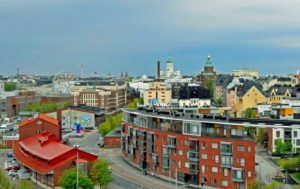
Central Section of Helsinki, Finland (Photo by Don Knebel)
In 1550, the King of Sweden, which controlled the area at the time, founded Helsinki as a trading village on a peninsula in the Gulf of Finland. The city began to grow in the nineteenth century after Russia defeated Sweden and took control of Finland. Today Helsinki, with a population of about 650,000, occupies its original peninsula and 315 islands, connected by bridges and water transportation.
Located just 2000 miles from the North Pole, Helsinki is, with the exception of Reykjavik, Iceland, the farthest north of all world capitals. For almost three months in the fall and winter, the sun hugs the horizon, providing about five hours of daylight. Winter temperatures rarely rise above freezing and temperatures of 25 degrees below zero are not unusual. Precipitation falls about 180 days a year, making Helsinki rainier than Seattle.
Despite its climate, Helsinki, always immaculately clean, is routinely ranked among the world’s most livable cities, having one of the world’s highest urban standards of living. The major sidewalks are heated in the winter. Residents not wanting to walk can take the efficient Helsinki Metro, the northernmost subway in the world. Four large indoor swimming halls allow year round swimming. Four other pools provide swimming exclusively for dogs, one offering half-hour lessons. World class museums and theatres provide extraordinary cultural opportunities for such a small city. And, of course, the ubiquitous Finnish saunas provide opportunities to be inside during the cold and dark days of winter. In 2012, Helsinki was named the World Design Capital for its innovative approaches.
Each year at least 5000 people move to Helsinki from all over the world. If you get a chance to visit this unique city, take advantage of it.
Comments are closed.